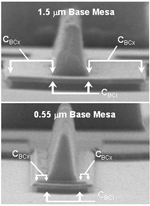
| Home | About Us | Contribute | Bookstore | Advertising | Subscribe for Free NOW! |
| News Archive | Features | Events | Recruitment | Directory |
| FREE subscription |
| Subscribe for free to receive each issue of Semiconductor Today magazine and weekly news brief. |
News
12 December 2006
Record 845GHz transistor reported by UIUC’s Feng
At this week’s International Electronics Device Meeting in San Francisco, CA, USA, Milton Feng’s group at the University of Illinois at Urbana-Champaign (UIUC) has again broken its own speed record for the world’s fastest transistor. With a speed of 765GHz operated at room temperature (25 degrees Celsius) and 845GHz when cooled to -55 degrees Celsius, the latest device is about 300GHz faster than transistors built by other research groups, it is claimed. Feng’s group only broke the 600GHz barrier just over a year and a half ago.
Made from InP and InGaAs, the latest heterojunction bipolar transistor uses a pseudomorphic grading of the base and collector regions. “The compositional grading of these components enhances the electron velocity and hence reduces both current density and charging time,” said Feng, who is the Holonyak Chair professor of Electrical and Computer Engineering at UIUC.
 In addition, the researchers also refined the fabrication process to produce smaller transistor features; the base is only 12.5nm thick. “By scaling the device vertically, we have reduced the distance electrons have to travel, resulting in an increase in transistor speed,” said graduate student William Snodgrass. “Because the size of the collector has also been reduced laterally, the transistor can charge and discharge faster,” he adds - see scanning electron microscope images of original base-collector
In addition, the researchers also refined the fabrication process to produce smaller transistor features; the base is only 12.5nm thick. “By scaling the device vertically, we have reduced the distance electrons have to travel, resulting in an increase in transistor speed,” said graduate student William Snodgrass. “Because the size of the collector has also been reduced laterally, the transistor can charge and discharge faster,” he adds - see scanning electron microscope images of original base-collector
mesa (top) and improved design (bottom).
Funded by the US Defense Advanced Research Projects Agency, Feng, Snodgrass and graduate student Walid Hafez (now at Intel Corp) fabricated the high-speed device in UIUC’s Micro and Nanotechnology Laboratory.
In addition to further increasing the transistor speed, Feng wants to reduce the current density even further, which will reduce junction temperature and improve device reliability.
Visit:
http://www.news.uiuc.edu